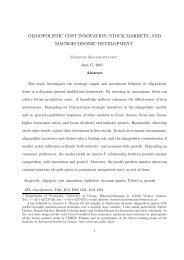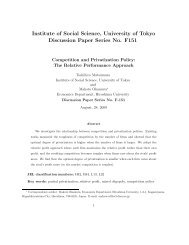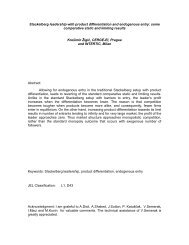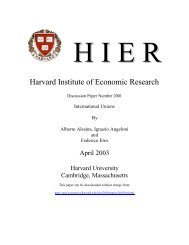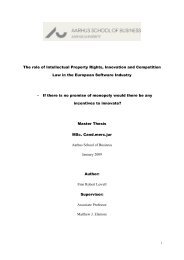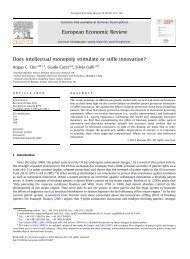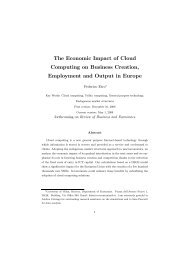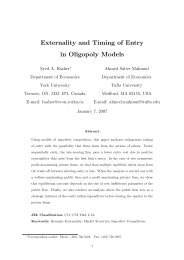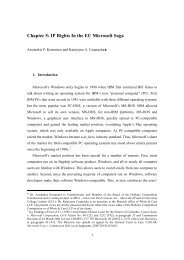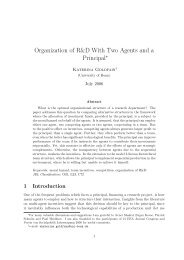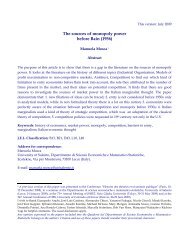The EU Approach to Abuse of Dominance - Intertic
The EU Approach to Abuse of Dominance - Intertic
The EU Approach to Abuse of Dominance - Intertic
Create successful ePaper yourself
Turn your PDF publications into a flip-book with our unique Google optimized e-Paper software.
(iv)<br />
(v)<br />
average <strong>to</strong>tal cost <strong>of</strong> the dominant firm could pr<strong>of</strong>itably enter only selling at least the<br />
fraction:<br />
pr<br />
xˆ<br />
=<br />
p − c<br />
which is defined as the required share.<br />
the rebate system ties a significant part <strong>of</strong> buyers; and<br />
there is no clear indications <strong>of</strong> significant entry or cus<strong>to</strong>mers’ switching.<br />
Fac<strong>to</strong>rs under (i), (ii) and (iii) seem highly unreliable for multiple reasons. First, the rebates<br />
under discussion are substantially equivalent <strong>to</strong> a pricing strategy with thre brackets. Indeed, <strong>to</strong>tal price<br />
as a function <strong>of</strong> <strong>to</strong>tal sales T is pT for TS, while it is constant at pS for<br />
intermediate values <strong>of</strong> sales between (1-r)S and S (since for these amounts <strong>of</strong> sales it is always better <strong>to</strong><br />
buy S and exploit the rebate). This implies that the pricing system is very similar <strong>to</strong> a simple quantity<br />
discount, which as well known has a welfare enhancing role. 15 <strong>The</strong> implication is that similar rebates<br />
should never be considered abusive when the percentage rebate is small enough since they have similar<br />
effects <strong>to</strong> simple quantity discounts.<br />
Second, any kind <strong>of</strong> fidelity rebate can have a pro-competitive role in the sense that it creates a<br />
further dimension <strong>of</strong> competition (the non-linear price schedule) and it can represent a more aggressive<br />
pricing strategy: hence an additional minimal condition for rebates <strong>to</strong> be abusive should be that<br />
competi<strong>to</strong>rs are not able <strong>to</strong> propose similar rebates or different ones (with different thresholds), but<br />
this issue is absent from the list <strong>of</strong> conditions.<br />
Third, the theoretical formulation <strong>of</strong> point (iii) is largely unrelated or inconsistent with standard<br />
economic theory and it is affected by a dangerous theoretical problem. <strong>The</strong> derivation <strong>of</strong> the formula<br />
for the required share is valid assuming that the ATC is constant. However, in general the average <strong>to</strong>tal<br />
cost is not constant and typically U-shaped, so that firms producing different amounts have different<br />
ATCs and there is usually a minimum ATC associated with a certain scale <strong>of</strong> production. Now, suppose<br />
that ATC depends on the fraction <strong>of</strong> sales x according <strong>to</strong> a general relation AC(x) – the particular case<br />
where this is constant is assumed by the Discussion Paper. Now, according <strong>to</strong> the reasoning <strong>of</strong> the<br />
Discussion Paper, foreclosure would require:<br />
⎛ r ⎞<br />
EP = p⎜1 − ⎟ < AC(<br />
x)<br />
⎝ x ⎠<br />
In general, this is not equivalent <strong>to</strong> a cut-<strong>of</strong>f rule for which the competi<strong>to</strong>rs’ required share<br />
exceeds the commercially viable amount per cus<strong>to</strong>mer. For instance, if we are in the range for which<br />
15 For instance see Massimo Motta, Competition Policy. <strong>The</strong>ory and Practice, Cambridge: Cambridge University Press,<br />
2004 (Chapter 7).<br />
13



